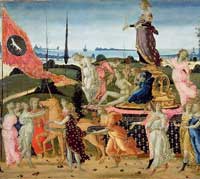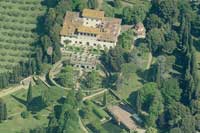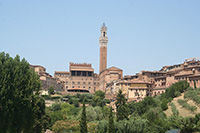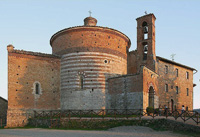Fiesole |
Fiesole is a town and comune of the Province of Florence, located on a scenic height above the city. Fiesole was probably founded in the eighth or ninth centuries BC, because it was an important part of the Etruscan confederacy, as can be seen in the remains of the ancient walls around the city. Fiesole was independent for several centuries in the early Middle Ages, and it almost held the same power that Florence did. However, many wars arose between Florence and Fiesole, and in 1010 and 1025 Fiesole was ransacked by Florentine’s. Fiesole was then conquered by Florence in 1125, and its leading families began to form residences in Florence as well. By the 14th century, wealthy Florentine families had villas in Fiesole.
|
Fiesole, Museo Bandini. I Trionfi di Jacopo del Sellaio (1442-1493): Trionfo d'Amore. |
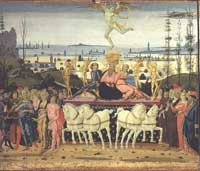 |
|||
Fiesole churches and villas |
||||
| Villa Medici |
||||
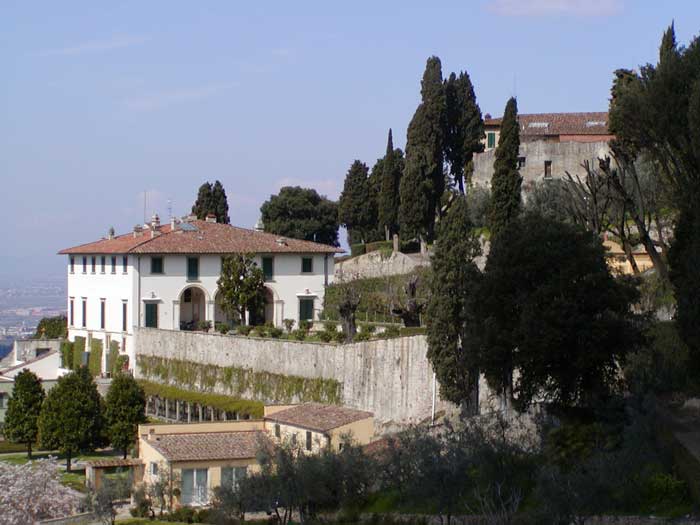 |
||||
Villa Medici in Fiesole, Firenze |
||||
After a stroll through Fiesole's town centre, from the main piazza, Piazza Mino, this easy downhill walk from Piazza Mino will take you on a visit through some of Fiesole's most beautiful and historic villas and breathtaking scenery with views into Florence and the surrounding hills. It ends at the church of San Domenico were the local bus (no.7) can then take you back to Florence or back up to Fiesole. |
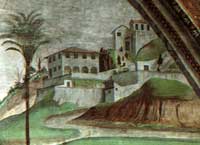 Domenico Ghirlandaio's fresco in the Tornabuoni chapel, Florence 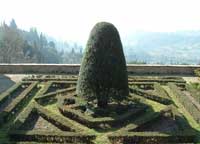 Villa Medici in Fiesole, lower garden |
|||
After a hairpin turn, still on Via Vecchia Fiesolana at number 21, is the Villa Rondinelli. Once called “the most splendid and grand” of the Fiesolan villas, it was constructed in the 16th century. Bought by Grand Duke Cosimo I (1519-1574) to give to his “secret servant” or personal attendant, Sforza Almeni, whom he lavished gifts onto in return for his trust. Sforza added to the villa, amplifying it with terraces, a pool and grotto, constructing a magnificent garden and a grand ballroom, essentially living like royalty until 1566. Cosimo, a widower after his wife Eleonora's sudden illness, had confided in Sforza of his incredible fatuation with a girl twenty-four years his junior, Eleonora degli Albizi, who brought newfound joy to the sad duke, having just given birth to their daughter. Sforza told Cosmio's son Francesco about the secret affair, and was murdered by the enraged Cosimo himself with a decorative spear off the wall of Palazzo Vecchio for having betrayed his trust. The villa was subsequently sold to the Salviati family, one of the richest and most prominent Florentine famlies, who over the centuries were connected to the Pazzi Conspiracy, the Pope and Galileo. |
||||
Villa Nieuwenkamp or Riposo dei Vescovi |
||||
Built over an existing farm building owned by Fiesole Abbey, this villa was transformed into a noble residence in the 19th century. It is said that the villa was used as a stopping-off place for bishops on their way from Florence to Fiesole, hence the name, which translates literally as "bishops' rest". In 1926 the villa, which had by then fallen into a very bad state of repair, became the home of Dutch artist W.O.J. Nieuwenkamp, who carried out a radical restoration operation, and adorned the garden with many fountains and other embellishments. The five-hectare garden is divided by a 230-metre-long avenue lined with cypress trees, and is on several different levels organised as a series of terraces edged with box hedges, cypress trees and laurels, connected by stone steps that follow the contours of the slope. At the point where the avenue leading off from the villa is crossed by side paths, stand various stone elements. Firstly two female busts, followed by a fountain on several levels and then an elliptical glade ringed by cypresses and edged with circular seating; a fountain, positioned against the boundary wall, forms the backdrop to the end of the walk. Nieuwenkamp decorated the park with statues, busts and archaeological finds. These include a bronze gong at the side of the building, a statue of Buddha, next to which is the artist's own tomb, and large conches and jars made of Impruneta terracotta that adorn the wall around the tennis court. Nieuwenkamp wrote two whole books about his villa and all the changes and additions he made both inside the house and out in the garden, work that he illustrated in great detail by more than a hundred superb drawings. Further along at no. 65 is Villa Papiniano, a residence used by important guests such as Pope Leo X (Lorenzo the Magnificent's son), is perhaps best known as the Villa of Baccio Bandinelli (1488-1560), the Medici court sculptor and rival of Michelangelo, famous for his unpopular sculpture of Hercules and Cacus that flanks the entrance of Palazzo Vecchio next to Michelangelo's David. He restored the villa in the mid-1500s before it was passed on to his son. In the 19th century, Fiesole became a fashionable area for wealthy anglo-saxons and much like the other villas, this one was owned by a series of foreign owners who added to the villa, inserting an English style garden and trippling the original size of Bandinelli's villa. Along the walls of the villa that follows the road, you can still spot the sign that attributes Baccio Bandinelli residence, above the sculpture of a lion's head. Villa Palmieri and Villa Schifanoiai |
||||
At the end of via Vecchia Fiesolana you come to the church and convent of San Domenico, founded in 1406 and housing important works by the likes of Fra Angelico. Many other priceless works used to decorate the walls of the church but in 1808 during Napoleon's sopression of the religious orders, the monks lost their church. They were able to buy it back in 1879 but to do so they had to sell a few of the paintings, including two Fra Angelico frescoes which were detatched from the walls and sold to the Louvre in Paris and the Hermitage in St Petersburg. The other works no longer in the church are two other Fra Angelico altarpieces, now in Madrid and the Louvre, and a stunning Perugino, now in Florence's Uffizi gallery. For a taste of convent life, the monks take bookings for visitors who want to stay in one of their 13 rooms.
On the slopes just below piazza San Domenico and Villa Schifanoia is the Villa Palmieri, named after the Renaissance humanist who lived here in the 15th century and famous for being the setting of Boccaccio's The Decameron, who describes in great detail the glorious medieval garden where his story-telling group of young men and women retreat to escape the Plague. The look now is more of a Victorian style with remants of a late 17th century Baroque design, which includes an often-photographed lemon garden. It was frequented by Queen Victoria herself, who stayed here several times when visiting the Earl of Crawford who owned the villa in the 19th century. For its celebrity status, the villa and gardens have been immortalised in countless paintings and etchings over the centuries, such as the Renaissance view of Botticini's Assumption, showing Florence in the background and the villa Palmieri on the hill top on the right (pictured below, top) and pre-Raphaelite John William Waterhouse's 19th century painting of the Decameron, set in a sumptous garden of a villa (pictured below, bottom). |
||||
View Larger Map of Villa Schifanoia |
||||
Villa Schifanoia, Via Giovanni Boccaccio, 50133, Firenze, Italia |
||||
|
||||
Gardens in Tuscany | Villa Palmieri and Villa Schifanoiai
Address : Villa il Palmerino, via del Palmerino 12 |
||||
|
||||
|
||||
|
||||
|
||||
|
||||
Transport The easiest ways to reach Fiesole to do this walk is to catch a local ATAF bus (you will see the word FIESOLE written on the front of the bus going in the right direction), which can be found at Piazza San Marco (on via Giorgio la Pira) and runs to and from Fiesole approximately every half hour until midnight. The bus will drop you off right in the main piazza of Fiesole, Piazza Mino. Local ATAF bus tickets can be bought in any tabaccheria (tobacconist) for 1,20 euro, usable more than once if within 90 minutes. Opening hours of the Churches: Church of Santa Maria Primerana, Piazza Mino Church of San Francesco, Via S. Francesco 13 Church and convent of San Domenico, Piazza San Domenico 4 Badia Fiesolana, Via della Badia dei Roccettini 9 Visiting the villas: Villa Medici, via Beato Angelico 2 Villa Nieuwenkamp, via Vecchia Fiesolana 62 Villa Schifanoia (European University Institute), via Giovanni Boccaccio 121 Villa Palmieri, via Giovanni Boccaccio
|
||||
|
||||
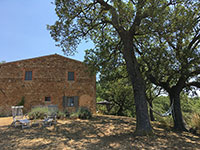 |
||||
Podere Santa Pia |
Podere Santa Pia, view from the garden on the valley below |
Podere Santa Pia | ||
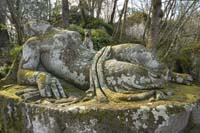 |
 |
 |
||
Il parco dei Mostri di Bomarzo |
Villa Lante, Bagnaia | Fontana del quadrato o dei mori in Villa Lante (Bagnaia) | ||
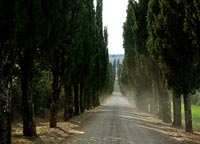 |
||||
Villa Arceno gardens |
L'eremo di Montesiepi (the Hermitage of Montesiepi) |
|||


